时间:2023-07-03 点击量:
建造环境(BERL)课题组刘素梅副教授在JCR Q1期刊《Building and Environment》(IF=7.093)发表论文,分析了新冠病毒感染者的位置、乘客的站立形态、换气次数等不同因素对可吸入病毒量的影响。
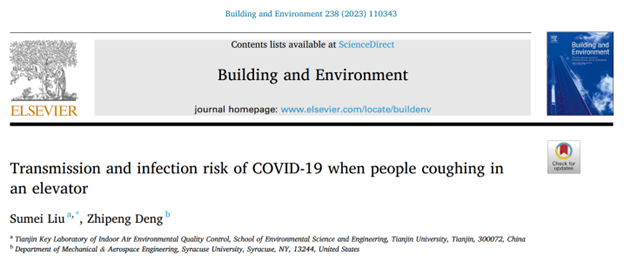
文章链接:https://www.sciencedirect.com/science/article/pii/S0360132323003700
1.题目
Transmission and infection risk of COVID-19 when people coughing in an elevator
电梯内新冠感染者咳嗽时COVID-19的传播和感染风险
2.作者
Sumei Liu (刘素梅,通讯作者), Zhipeng Deng(邓志鹏)
3.研究亮点
Source locations, standing postures, and ventilation rates influence exposure to COVID-19 in elevators.
The individual in front of or next to the infected person faces the greatest infection risk.
With a 3 and 30 ACH ventilation rate, the highest inhaled virus copies could be 1186 and 509, respectively.
Wearing masks could reduce the highest number of inhaled virus copies to 74.
感染者位置、乘客站立形态和通风量会影响电梯内COVID-19的暴露量。
站在感染者前面或旁边的乘客感染风险最大。
当换气次数为3和30时,易感乘客最大吸入病毒拷贝数分别为1186和509。
佩戴医用外科口罩可将吸入病毒的最高拷贝数减少到74。
4.摘要
People in cities use elevators daily. With the COVID-19 pandemic, there are more worries about elevator safety, since elevators are often small and crowded. This study used a proven CFD model to see how the virus could spread in elevators. We simulated five people taking in an elevator for 2 min and analyzed the effect of different factors on the amount of virus that could be inhaled, such as the infected person’s location, the standing positions of the persons, and the air flow rate. We found that the position of the infected person and the direction they stood greatly impacted virus transmission in the elevator. The use of mechanical ventilation with a flow rate of 30 ACH (air changes per hour) was effective in reducing the risk of infection. In situations where the air flow rate was 3 ACH, we found that the highest number of inhaled virus copies could range from 237 to 1186. However, with a flow rate of 30 ACH, the highest number was reduced to 153 to 509. The study also showed that wearing surgical masks decreased the highest number of inhaled virus copies to 74 to 155.
城市里的人每天都使用电梯,电梯空间往往又小又拥挤,随着新冠肺炎疫情的爆发,导致人们对电梯安全的担忧越来越多。本文使用一个经过验证的CFD模型来研究病毒如何在电梯中传播,研究模拟五个人乘坐电梯2分钟,分析感染者的位置、乘客的站立形态、通风量等不同因素对可吸入病毒量的影响。研究发现,感染者站立的位置和乘客站立的方向对电梯内病毒的传播有很大影响。电梯内使用通风量为30 ACH(换气次数)的机械通气系统可有效降低感染风险。通风量为3 ACH(自然渗透风量)的情况下,易感乘客吸入的最高病毒拷贝数在237到1186之间;而当通风量为30 ACH时,易感乘客吸入的最高病毒拷贝数可减少到153至509。该研究还表明,佩戴医用外科口罩可将吸入最高病毒拷贝数减少到74至155。
5.文中部分插图
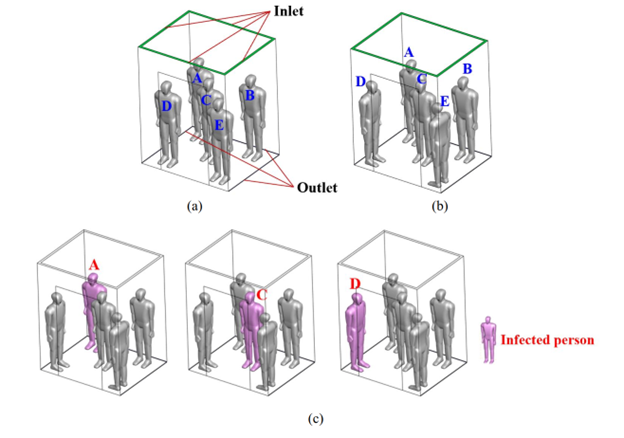
Fig. 1. Geometry model of the elevator and persons: (a) standing posture of scenario I – all persons facing the elevator door, (b) standing posture of scenario II – all persons standing against the walls, (c) different source locations and infected person.
图1. 电梯和人体几何模型:(a)站立形态|—所有人面对电梯门,(b)站立形态||—所有人靠墙站立,(c)不同的感染源位置。
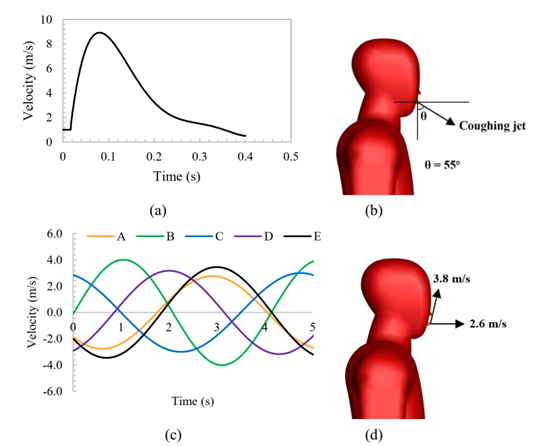
Fig. 2. The fluid boundary conditions: (a) coughing velocity produced by the infected person [43]; (b) the coughing jet direction, there was a downward angle based on Gupta et al. [43]; (c) the air velocity of asynchronous breathing distributions [42] assigned at the nose of each person. For subsequent times, it was assumed that breathing would fluctuate periodically; (d) coughing velocity with wearing a mask.
图2. 流体边界条件:(a)感染者咳嗽速度[43];(b)咳嗽射流方向,根据Gupta等人的研究[43],咳嗽气流有一个向下的角度;(c)每个人鼻子的呼吸气流速度分布[42],在整个计算时间内呼吸呈周期性变化;(d)戴口罩时咳嗽气流速度。
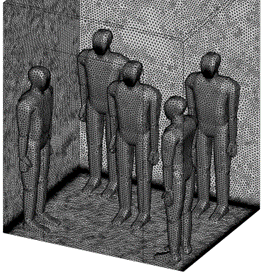
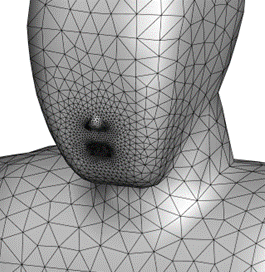
Fig. 4. Grid distribution used in this study: (a) in the elevator, and (b) near the mouth and nose of the person.
图4. 本研究使用的网格分布:(a)在电梯内,(b)在人的口鼻附近。

Fig. 7. Distributions of virus-laden particles expelled from a single cough in the elevator of Case 1 over time.
图7. 基准算例1中感染者单次咳嗽排出的病毒颗粒在电梯内随时间的分布。
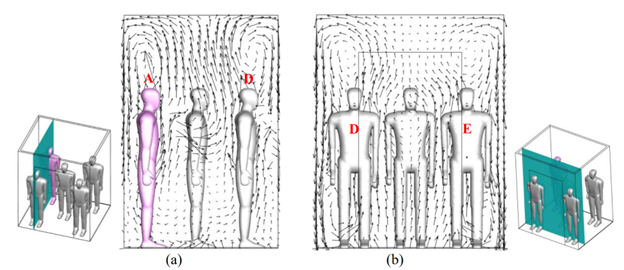
Fig. 8. Velocity distributions in the elevator of Case 1 at t = 120 s: (a) airflow in the surface across infected person A and person D, (b) airflow in the surface across persons D and E.
图8. 基准算例1中,在t = 120s时电梯内的速度分布:(a)穿过感染者A和乘客D截面的速度场,(b)穿过乘客D和E截面的速度场。
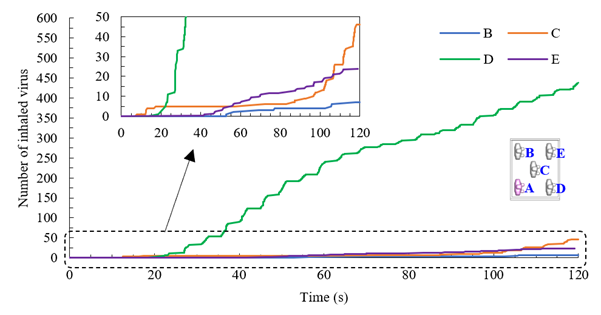
Fig. 9. Accumulated dose for each person in Case 1.
图9. 基准算例1中每个乘客的累积吸入病毒拷贝数。
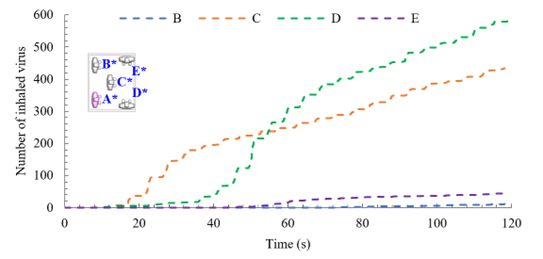
(a) Standing scenario II, cough by infected person A (Case 2)
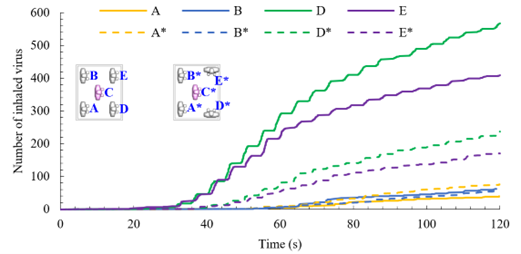
(b) Standing scenarios I & II, cough by infected person C (Case 3 & 4)
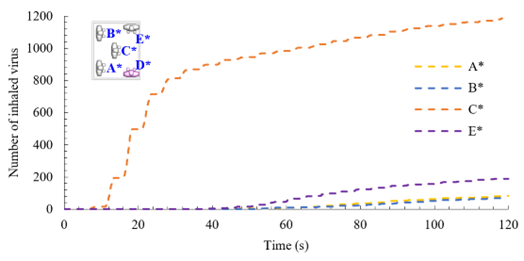
(c) Standing scenario II, cough by infected person D (Case 5)
Fig. 10. Comparison of the accumulated inhaled virus in different cases for 3 ACH.
图10. 不同算例中乘客累积吸入病毒拷贝数的比较。
6.结论
In this study, the validated CFD model was employed to investigate the potential transmission of COVID-19 through coughing in an elevator. We computed the number of virus particles inhaled by susceptible persons during a two-minute ride in the elevator. The study led to the following conclusions:
· For the baseline base, the virus particles reached the breathing zone of person D at 20 seconds. This person inhaled 438 virus copies during a two-minute elevator ride, which could result in infection. On the other hand, the number of virus copies inhaled by the remaining three persons was less than 50, which may not lead to infection.
· The results revealed that the position of the source and the standing posture significantly impacted the spread of particles in the elevator. In both standing postures, the person standing in front of or beside the infected person was found to inhale the highest number of virus copies, which could reach 1186 during a two-minute elevator ride.
· The study evaluated the effect of various ventilation rates on the risk of infection. The results showed that using a mechanical ventilation system with a flow rate of 30 air ACH reduced the COVID-19 transmission in the elevator. In 3 ACH scenarios, the highest number of inhaled virus copies ranged from 237 to 1186, while in the 30 ACH scenarios, the highest number was reduced to 153 to 509.
· The study investigated the impact of wearing surgical masks on the risk of infection. In 3 ACH scenarios with standing posture II, wearing surgical masks was found to reduce the highest number of inhaled virus copies to 74 to 155.
本研究采用经过验证的CFD模型对新冠患者在电梯内咳嗽时COVID-19的潜在传播风险进行了研究。研究计算了易感人群在乘坐电梯的两分钟内吸入的病毒拷贝数。研究得出以下结论:
· 对于基准案例(3ACH,感染者位置为A),病毒颗粒在20秒到达乘客D的呼吸区。乘客D在乘坐电梯的两分钟内吸入病毒拷贝数为438,可能导致感染(感染阈值为400)。其余3人吸入的病毒拷贝数少于50,可能不会导致感染。
· 结果表明,感染源位置和乘客站立形态对病毒在电梯内的传播有显著影响。在两种站立形态中,站在感染者前面或旁边的人吸入的病毒拷贝数最多,在乘坐电梯的两分钟内病毒拷贝数可达到1186。
· 本研究评估了不同通风量对感染风险的影响。结果表明,电梯内使用通风量为30 ACH(换气次数)的机械通气系统可有效降低感染风险。通风量为3 ACH(自然渗透风量)的情况下,其他乘客吸入的最高病毒拷贝数在237到1186之间;而通风量为30 ACH时,其他乘客吸入的最高病毒拷贝数可减少到153至509。
· 本研究评估了佩戴医用口罩对感染风险的影响。对于站立姿势II、通风量为3 ACH的情况,佩戴医用外科口罩可将吸入病毒的最高病毒拷贝数减少到74至155。
本文引用格式:
Liu S, Deng Z. Transmission and infection risk of COVID-19 when people coughing in an elevator. Building and Environment, 2023, 238: 110343.
稿件编辑:刘素梅
稿件审核:刘俊杰、田媛、何明桐
